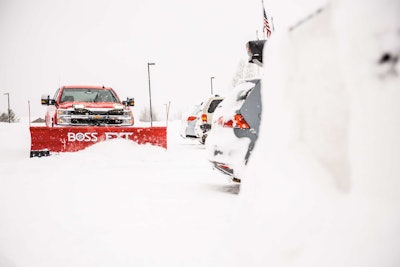 Photo: Boss Snowplow
Photo: Boss SnowplowAs Winter Storm Harper moves from the West to the Plains, Midwest and Northeast this weekend, your crews may be gearing up for some serious snow plowing.
Depending on where you are located will impact just how much snow you can expect and when it will arrive, with areas like New York state and New England forecasted to receive more than 24 inches of snow.
As you set out to fulfill your snow removal contracts for clients, keep some of these basic practices in mind to ensure the safety of your team members and that quality work is done.
Winter driving
The three P’s of safe winter driving according to the Occupational Safety & Health Administration (OSHA) are: Prepare for the trip, Protect yourself and Prevent crashes on the road.
Before crew members leave for a job, make sure that vehicle systems like the brakes, engine, tires, oil, electrical system and visibility systems are all in proper working order. Each vehicle should have an emergency kit including a flashlight, jumper cables, a cellphone or two-way radio, an ice scraper, food and water, blankets, abrasive material and a shovel.
When traveling to a site, allow for plenty of time and match your driving speed to the current conditions. If conditions are challenging due to a slippery road surface or reduced visibility, decrease your speed. A slower driving speed allows more time for a necessary response.
Boss Snowplow advises not exceeding 40 mph when transporting a plow and to not go faster than 14 mph when plowing.
Strive to anticipate potentially dangerous situations. When approaching a curve or potentially slick area of the road, use the brakes effectively. The brakes should be applied only before a curve and on a straight section of the road. Sometimes, taking your foot off the accelerator and allowing the vehicle to naturally slow without using the brakes is best.
Even if you have anti-lock brakes, four-wheel drive, winter tires or other features designed to help with winter driving, do not allow these to give you a false sense of security and cause overconfident driving.
Maintain enough distance between your vehicle and the one ahead of you. If someone else seems to be following too close to your vehicle, perhaps slow down to allow them to pass – rather than speeding up to achieve a distance between vehicles.
Plowing parking lots
One of the common sites you’ll probably be in charge of clearing is various parking lots, as the majority of businesses can’t afford to close just because of some snow.
When a significant amount of snow is expected, it is better to plow during the storm than allowing it to accumulate. This can mean having to plow while the business is still open, so always plow with care and watch for customers, cars and property.
Start by clearing in front of buildings and pushing the snow away from the buildings. Continue to make passes in long, straight lines. Once snow has been cleared away from the buildings, start by making a pass in the center of the lot and push snow in windrows to the outer areas.
If the parking lot is particularly large, it might be best to break this up into smaller sections.
As for the width of the passes, the rule of thumb is the plow with the entire blade if there is two inches of snow or less. For four inches of snow, use three quarters of the blade and for six inches of snow or more use half a blade.
Before leaving a jobsite, ensure the lot has been plowed according to your contract. Look for clumps of snow that can freeze into hard pack and remove them.
Piling snow
Knowing where to put the snow you’re plowing before you start is crucial to doing your job efficiently and safely.
For many property owners, they may already have a location that they want to have their snow piles placed. This should be included in their contract, but you should also know if the desired snow plow area is potentially dangerous or hazardous location and discuss this with them.
Never place snow piles by mailboxes, dumpsters, fire hydrants, driveways or sidewalks or anything else a customer may need access to. Be mindful of drains and catch basins and do not block these as it can result in flooding and ice hazards from refreezing.
The ideal place to pile snow is away from buildings and it needs to be both downhill and downwind to prevent drifting. This isn’t always possible, but it should be taken advantage of when it is an option.
Because you never know when the next winter storm will hit, it’s always a good idea to think two storms ahead. Making sure there’s enough room for future snow piles will save you from trouble later in the season.









